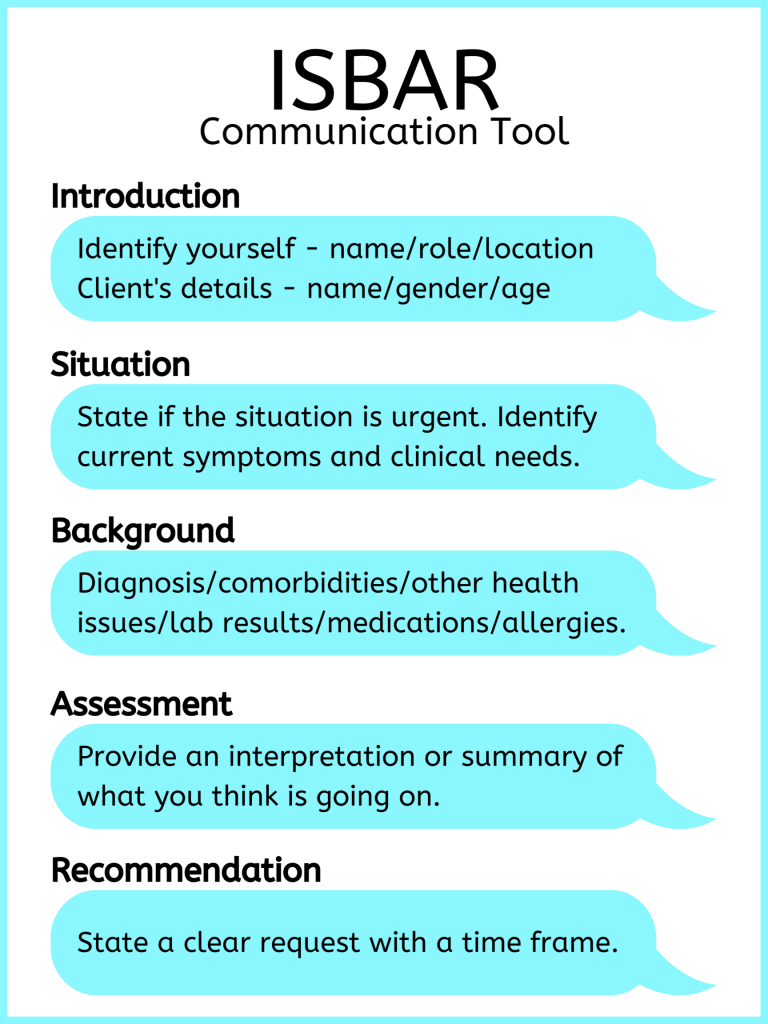Chapter 3 – Interprofessional Communication in Nursing
Resources to Facilitate Interprofessional Communication
There are numerous resources to facilitate interprofessional collaboration and teams, including interprofessional communication.
Ideally, all healthcare professionals including nurses would speak up for the sake of clients, clearly state what they think is happening in a specific situation, and explain what and why they think certain actions should be taken (Lyndon et al., 2011). However, some healthcare professionals may struggle to voice their concerns and their perspectives, particularly if they feel less empowered or marginalized by another healthcare professional. One objective of interprofessional communication tools is to provide structure and clarity to convey succinct, comprehensive, and relevant information to another healthcare professional to improve client care.
Several standardized tools have been developed to facilitate interprofessional communication (Canadian Medical Protective Association, 2011) and prevent and manage harassment, errors in the workplace, and miscommunication. The SBAR tool, and its variations including ISBAR, is one common communication tool that can facilitate effective verbal communication when communicating with another healthcare professional about a client or during handover. It provides a framework so that communication is focused, concise, and complete.
ISBAR, detailed in Figure 3.7, is an acronym for Introduction, Situation, Background, Assessment, Recommendation. It was first introduced by the military in the United States to facilitate communication (NHS Improvement, n.d.) and has since been taken up in the healthcare arena to enhance client safety by facilitating communication among healthcare professionals and ensure the most important information is included (NHS improvement, n.d.; Spooner et al., 2016).

Figure 3.7: ISBAR
Using the ISBAR effectively takes practice. Check out Film Clip 3.1 about ISBAR [3:08].
Film Clip 3.1: ISBAR
Research suggests that nurses do not comprehensively use elements of ISBAR, and the sections on assessment and recommendation are consistently neglected (Spooner et al., 2016). It is important to reflect on how you communicate and how you can improve through comprehensive use of tools. See Table 3.4 for an example of effective use of the ISBAR to guide communication.
Table 3.4: Example of ISBAR Use
|
I – Introduction
|
“Hello, I am calling about Zina Mills, a 45-year-old female client on 3C. I am Sandu Martique, a registered nurse on the unit.”
|
|
S – Situation
|
“The client is experiencing shortness of breath with a productive cough, and green mucous times three days. Currently, she has moderate crackles throughout the left lobe. 02 sat is 90%, respiratory rate is 26, temp is 38.3, pulse 98, blood pressure 134/88, and she is on 4 litres oxygen via nasal prongs.”
|
|
B – Background
|
“The client has been in this facility for 4 days following hip surgery. Her incisions show no signs of infection. However, her mobility has been limited due to moderate dementia. She has a history of hypertension, no previous lung disease, and is a non-smoker.”
|
|
A – Assessment
|
“Based on my assessment, her symptoms may be associated with pneumonia.”
|
|
R – Recommendation
|
“Would you like a chest x-ray done? And when do you have time to see the client?”
|
Points of Consideration
Think about what you want to say and how you want to say it before you say it. Organize your thoughts first.
Activity: Check Your Understanding

